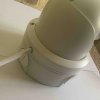Has anyone run the cameras cable plus an additional Cat 6 cable through the single junction box grommet at the same time? In other words 2 cables in the same hole? Here's pictures because I don't know how else to describe this.
If you look at the following picture, I'd rather not put the coupler on the junction box for the Cat 6 and just run it in the hole provided by the camera (circled).

Here is a mock up of what I am thinking of doing

There is a gap where there is a break in the grommet that I can fill with silicone caulk and this will be under an eave/soffit so shouldn't get any moisture other than relative humidify. I will put dielectric grease in the actual connector and use the provided joint protector. My bigger concern is it "pinching" the Cat 6 cable as you can see in this picture:

And the blue cable in the picture is not the outdoor rated cable. For the actual install I will be using outdoor rated Cat 6 which is thicker.
I would keep the cameras cable in the center of the hole so that if anything does get damaged it will be the Cat 6 which can easily be replaced cut and new connector installed (providing some slack inside the eave.
Anyone do this and ever have an issue? I tried squeezing the Cat 6 closer to the camera cable but once you start closing the grommet it pushes it out.
If you look at the following picture, I'd rather not put the coupler on the junction box for the Cat 6 and just run it in the hole provided by the camera (circled).

Here is a mock up of what I am thinking of doing

There is a gap where there is a break in the grommet that I can fill with silicone caulk and this will be under an eave/soffit so shouldn't get any moisture other than relative humidify. I will put dielectric grease in the actual connector and use the provided joint protector. My bigger concern is it "pinching" the Cat 6 cable as you can see in this picture:

And the blue cable in the picture is not the outdoor rated cable. For the actual install I will be using outdoor rated Cat 6 which is thicker.
I would keep the cameras cable in the center of the hole so that if anything does get damaged it will be the Cat 6 which can easily be replaced cut and new connector installed (providing some slack inside the eave.
Anyone do this and ever have an issue? I tried squeezing the Cat 6 closer to the camera cable but once you start closing the grommet it pushes it out.





